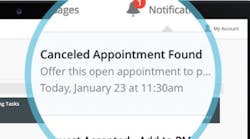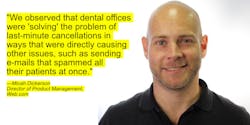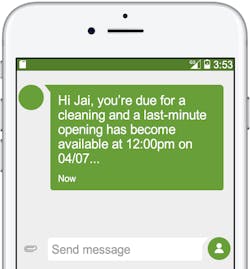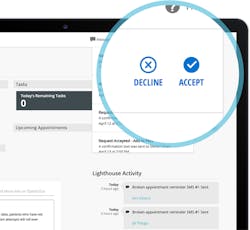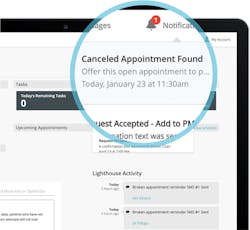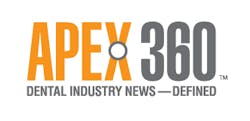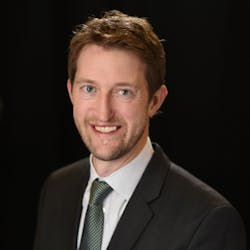How Lighthouse 360 solved the $30,000 patient cancellation problem: An interview with Web.com's Micah Dickerson
EVERYONE WHO WORKS IN A DENTAL PRACTICE, from dentist to hygienist to receptionist, knows how deflating patient cancellations can be. From a production standpoint, it has been estimated that cancellations cost the average practice $30,000 a year in lost revenue. (1) But thanks to leaps in dental software (along with the innovative companies developing it), dental practices are starting to reclaim that $30,000.
Recently, I had a chance to interview Micah Dickerson, director of product management for Web.com. Dickerson oversees the company's Lighthouse line of patient communication software for dental practices. This month, Dickerson and his team released the "Fill-In" enhancement to their Lighthouse 360 patient communication and scheduling software. The Fill-In feature does exactly what its name implies: it "fills in" unexpected schedule openings quickly and efficiently.
Here's what Dickerson had to say about the "Fill-In" feature, along with trends in the dental industry that we should all pay attention to.
Lighthouse 360 is a powerful communication and scheduling tool for dental practices, and you've just added a new "Fill-In" feature. What is it and how does it work?
Fill-In is the first feature of its kind within the dental industry. It automatically detects and fills last-minute cancellations. The new Fill-In feature directly complements our existing Lighthouse 360 software—both in its functionality and its mission.
What is that mission?
For the last 10 years, Lighthouse 360 has automated tedious dental practice tasks so more than 11,000 dentists can focus on what's most important: their patients.
Cancellations are a major downer for practices big and small. Tell us more about how Fill-In addresses this problem.
With the new Fill-In feature, our product development team is tackling the last-minute patient cancellations, which are the costliest and one of the most underserved problems in the dental industry. Not only does the feature help dental practices combat the stress and financial burden of filling those last-minute cancellations, but it also makes appointments available to patients who really want them.
From a functional standpoint, the feature is an enhancement to our current product. It is available to new and existing clients for no additional cost.
Above: Lightouse 360 developers worked with dentists to make the cancellation "Fill-In" process as simple as possible.
Describe to us how the Fill-In feature came about. Was this something your clients were asking for, something you've seen in other industries, or something else?
It really came about through our relationships with dental practices across the country and our own research into the industry. We observed real dental office behavior to learn about the needs of dental offices and their patients and how we could develop solutions to address those problems.
We’ve found that one of the biggest pain points for dentists and their offices is last-minute scheduling changes that not only threatened the financial performance of the practice, but the overall morale of the staff members who were tasked with trying to quickly fill a cancellation. We observed that dental offices were “solving” the problem of last-minute cancellations in ways that were directly causing other issues, such as sending e-mails that spammed all their patients at once.
With Fill-In, our goal is to improve this enormous pain point through automation, allowing dentists and their teams to take care of their patients.
Can you give us some details on the practice management impact that Fill-In could have on a practice? For example, can you give us some idea of potential revenue impact?
Based on our research, we see this as a solution that will largely impact current revenue structures in the industry and better support dentists and their practices.
Last-minute cancellations are one of the costliest and most common challenges facing dental practices. In one of our studies, dentists said a solution for last-minute cancellations was their top need by a huge margin.
DentistryIQ and the Hartford Business Journal, among others, have cited that just one no-show or cancellation each day can potentially cost dental practices $30,000 in lost revenue each year. The new Fill-In feature gives practices the opportunity to avoid lost revenue and better serve their customers by automatically offering up coveted appointments to those most likely to want them.
How did you test Fill-In before bringing it to market?
With Fill-In, we tested and eased into the market gradually. We knew that we wanted to address the issue of last-minute cancellations that was costing dental practices valuable revenue and wreaking havoc on office staff, but first we needed an idea.
To start, our product development team brainstormed ways that we could address the burden of last-minute cancellations. Once we had the idea for Fill-In in place, we developed different prototypes and tested in a dental office with a real dentist and real patients. We then beta tested with different dental offices, which provided continual feedback over weeks of testing. Based on the stream of feedback, we made refinements and improvements to the solution and eventually brought it to market.
The new Fill-In feature works seamlessly with the existing Lighthouse 360 platform and is easy to use and intuitive. The feature detects last-minute cancellations in a dentist’s schedule and automatically reaches out to patients most likely to want the vacated appointment—such as those who are overdue for their checkups or have requested a more immediate appointment time. Once a patient has confirmed interest, the dentist simply approves the new appointment.
Although most dental practices will be able to use the feature with little to no training, one of our greatest strengths is our award-winning customer support team, who is behind the scenes to provide support both for the new Fill-In feature and the entire platform. We are on hand to demo the feature and how it integrates with the existing platform, and are also available every step of the way to answer any questions that may arise from using the feature in day-to-day operations or address other practice needs.
In the last five years, dentists have been bombarded with new software products, each one carrying promises of outstanding ROI. As competition has increased, how has Lighthouse 360 maintained its competitive advantage?
Lighthouse 360, a Web.com brand since 2016, has primarily maintained its competitive advantage by listening to our clients to create solutions that are designed specifically for the dental industry, best address their needs, and ultimately deliver results. You don’t stay competitive by copying what others are doing, and we’re focused on our clients and solving their problems in powerful ways.
Lighthouse 360’s automated patient-messaging capabilities have helped customers increase production by an average of 30%. Our features that are designed to boost practice efficiency save dental practices an average of 16 hours per week and eliminate seven hours of weekly phone time for the front desk. Furthermore, 80% of our dental clients say using Lighthouse 360 has increased the overall happiness of their staff.
Importantly, our overall Web.com team culture is built on listening to the needs, challenges, and opportunities our customers face so we can deliver tailored advice that enables them to succeed online and with customers. It’s that human element, combined with our high-quality products, that have made Web.com a leader in providing online solutions and have made Lighthouse 360 a leader in dental practice software.
Our audience—primarily dentists—is keen to stay ahead of dental industry trends. Can you provide three trends you're seeing in patient communication or dentistry in general that our audience should be aware of? In other words, where are we headed and how can our dental audience stay ahead?
Dental practices can stay ahead by knowing that what’s good for patients is also good for them, and that means embracing new technology to systemize and improve the patient experience. Our ultimate goal is to help our clients better serve their own patients’ needs, whether that’s by helping dental practices communicate in the ways people prefer (such as texts) or making paying bills an easier process.
We’re also seeing more and more dental practices join larger dental organizations so that the practitioner can stay focused on patient care. The takeaway here is that dental practices are looking for ways to tackle an ever-growing list of demands without losing focus on the clinical side.
Finally, there is a ton of innovation going on within the dental software industry. Being an early adopter of such innovations could differentiate yourself among competitive landscapes and help drive new patients to your practices. Patients are expecting better and easier experiences, and offering those experiences is an important differentiator for practices.
Is there anything else you'd like us to know about Lighthouse 360? And what we can look for in the future from you?
There have been so many innovations to patient communication software—especially with Lighthouse 360—within the past two years. If dental practices have been using the same software for a long time without shopping around, they might be missing out or settling for a system that isn’t working hard enough for them. We offer free demos of our Lighthouse 360 platform so dental practices can test what a modernized, robust system can do for them.
Lighthouse 360 was one of the first solutions to provide automated patient communication specifically designed for dental practices. We are now looking for even more ways to innovate and help dental practices. Our team conducts regular research with both patients and dental practices to identify their pain points and see where we can create solutions that address both needs, ultimately improving the experience for the patient and helping the dental practice remain profitable. We are constantly innovating our Lighthouse 360 platform and looking for ways we can deploy new technology to provide solutions—such as our Fill-In enhancement. In the future, you can be sure to see new innovations from us that address important needs for dental practices, all while tying back to that crucial patient experience.
References
1. Long R. Reducing the cost of cancellations in your dental practice.DentistryIQwebsite. http://www.dentistryiq.com/articles/2015/07/reducing-the-cost-of-cancellations-in-your-dental-practice.html. Published July 24, 2015. Accessed August 1, 2017.
About Micah Dickerson
Micah Dickerson is a director of product management at Web.com. He is responsible for its award-winning Lighthouse line of patient communication software for dentists. Dickerson previously managed key areas of AutoCAD and AutoCAD for Mac at Autodesk. Through his work with Web.com, Micah studies the overall dental patient experience and looks for ways that technology can improve upon it. He has worked in the software world for more than 17 years. His background includes architecture, web technologies, market research, and visual design. Micah is a graduate of the University of California with additional education in graphic design and architecture.
MORE FROM THIS AUTHOR:
15,000 patients a day: Exclusive interview with Bob Fontana, CEO of Aspen Dental Management Inc.
Dental school disruption 101: The story of CRET
The making of master craftsmen: Inside the groundbreaking Hu-Friedy apprenticeship program
Editor's note: This article first appeared in the Apex360 e-newsletter. Apex360 is a DentistryIQ partner publication for dental practitioners and members of the dental industry. Its goal is to provide timely dental information and present it in meaningful context, empowering those in the dental space to make better business decisions. Subscribe to the Apex360 e-newsletter here.
For the most current dental headlines, click here.
About the Author

Zachary Kulsrud
Zachary Kulsrud is the editorial director for Endeavor Business Media's dental group, publishers of Dental Economics, DentistryIQ, Perio-Implant Advisory, and RDH magazine.
Updated July 7, 2020
